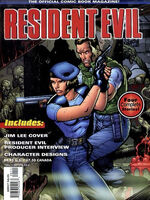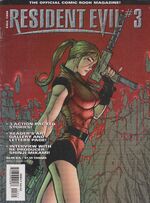m (clean up) |
No edit summary Tag: Visual edit |
||
| (9 intermediate revisions by 6 users not shown) | |||
| Line 1: | Line 1: | ||
| + | {{Articletype|wildstorm}} |
||
| − | '''''Resident Evil: The Official Comic Magazine''''' was a five-part series of quarterly-released comics published by WildStorm, a DC Comics subsidiary, between March 1998 and February 1999. |
||
| + | '''''Resident Evil: The Official Comic Magazine''''' was a five-part anthology series of comics published by [[WildStorm]] from March 1998-February 1999. The series was one of several moves by Capcom Co., Ltd. and Capcom USA to advertise the games to other demographs through licensing.<ref>{{Cite web|url = http://www.projectumbrella.net/articles/Marc-Mostman-Interview-Project-Umbrella|title = Marc Mostman Interview (Project Umbrella)|accessdate = 2020-03-22}}</ref> The stories themselves are not part of the prime continuity the games inhabit, and while there was a degree of overhead and provision of concept art, writers were free to fill in gaps not known to foreign fans. |
||
==Plot== |
==Plot== |
||
| Line 50: | Line 51: | ||
==Differences between the Mainstream and WildStorm universes== |
==Differences between the Mainstream and WildStorm universes== |
||
| − | Like the S.D. Perry novels, the comics also explored events occurring beyond ''[[Resident Evil 2]]'' (the latest game during the series' publication) and thus were contradicted by later games. The following are a few examples: |
+ | Like the S.D. Perry novels, the comics also explored events occurring beyond ''[[Resident Evil 2 (1998 game)|Resident Evil 2]]'' (the latest game during the series' publication) and thus were contradicted by later games. The following are a few examples: |
*The name of the [[Kendo Gun Shop]] owner is given as "George." His name was later revealed to be [[Robert Kendo|Robert]] in ''Resident Evil 3: Nemesis''. |
*The name of the [[Kendo Gun Shop]] owner is given as "George." His name was later revealed to be [[Robert Kendo|Robert]] in ''Resident Evil 3: Nemesis''. |
||
| − | *That [[licker]]s are described as a product of the [[G- |
+ | *That [[licker]]s are described as a product of the [[G-Virus (WildStorm)|G-Virus]], rather than being mutated zombies ([[t-Virus]] creatures). |
*The G-Virus and t-Virus are mostly interchangeable. Several stories in the comics depict zombies being created as a result of the G-Virus, and animals and humans being seemingly impregnated by the mutated [[William Birkin]] turning into zombies upon rejecting the G-embryo, instead of the infant mutant bursting from their bodies. |
*The G-Virus and t-Virus are mostly interchangeable. Several stories in the comics depict zombies being created as a result of the G-Virus, and animals and humans being seemingly impregnated by the mutated [[William Birkin]] turning into zombies upon rejecting the G-embryo, instead of the infant mutant bursting from their bodies. |
||
*[[Raccoon City]]'s infection was the result of a test tube containing a t-Virus sample being flung into a river when the [[Spencer Mansion]] blew up, thus contaminated its water supply. |
*[[Raccoon City]]'s infection was the result of a test tube containing a t-Virus sample being flung into a river when the [[Spencer Mansion]] blew up, thus contaminated its water supply. |
||
| − | *The release of the t-Virus at the mansion was a deliberate act on the part of [[Umbrella]] to test its effects on humans. |
+ | *The release of the t-Virus at the mansion was a deliberate act on the part of [[Umbrella Corporation|Umbrella]] to test its effects on humans. |
==Merchandise== |
==Merchandise== |
||
| − | Ninety 'character cards' were published by WildStorm to advertise their series. These cards included 36 each of Leon and Claire; 9 on various creatures; another three focused specifically on the [[T-00]] and six more on |
+ | Ninety 'character cards' were published by WildStorm to advertise their series. These cards included 36 each of Leon and Claire; 9 on various creatures; another three focused specifically on the [[T-00]] and six more on [[G|"G"]]. |
<gallery type="slideshow"> |
<gallery type="slideshow"> |
||
| Line 174: | Line 175: | ||
WildStorm character card - S9.jpg|Card 'S9' (watermarked) |
WildStorm character card - S9.jpg|Card 'S9' (watermarked) |
||
</gallery> |
</gallery> |
||
| + | {{Comics navigation}} |
||
{{Comics|wildstorm}} |
{{Comics|wildstorm}} |
||
| + | [[es:Resident Evil: The Official Comic Magazine]] |
||
| − | [[Category: |
+ | [[Category:WildStorm comics]] |
Revision as of 04:08, 22 March 2020
(Covers information from the D.C. comics)
Resident Evil: The Official Comic Magazine was a five-part anthology series of comics published by WildStorm from March 1998-February 1999. The series was one of several moves by Capcom Co., Ltd. and Capcom USA to advertise the games to other demographs through licensing.[1] The stories themselves are not part of the prime continuity the games inhabit, and while there was a degree of overhead and provision of concept art, writers were free to fill in gaps not known to foreign fans.
Plot
The series was a compilation of short stories consisting of adaptations of the first two games' events (alluded and depicted) and related side-stories along with original tales. The ending of Issue #5 was followed by Resident Evil: Fire and Ice in 2001, which continued on as a single story, using several characters from the Official Comic Magazine. A third entry in the series, simply titled "Resident Evil" (though referred to as "Resident Evil Vol 2" in copyright documents) was released in 2009, though made no mention of the events of the first two entries.
Issues
| Issue no. | Cover art | Release date | Stories |
|---|---|---|---|
| Issue #1 | 
|
March 1998 | "S.T.A.R.S. Files" "Who Are Those Guys?" |
| Issue #2 | 
|
June 1998 | "A New Chapter of Evil" "Mutant Menagerie" |
| Issue #3 | 
|
September 1998 | "Wolf Hunt" "Danger Island" |
| Issue #4 | 
|
December 1998 | "Night Stalkers" "Special Delivery" |
| Issue #5 | 
|
February 1999 | "...And the Last Shall Be First" "Emmy's Bloody Spoon" |
Differences between the Mainstream and WildStorm universes
Like the S.D. Perry novels, the comics also explored events occurring beyond Resident Evil 2 (the latest game during the series' publication) and thus were contradicted by later games. The following are a few examples:
- The name of the Kendo Gun Shop owner is given as "George." His name was later revealed to be Robert in Resident Evil 3: Nemesis.
- That lickers are described as a product of the G-Virus, rather than being mutated zombies (t-Virus creatures).
- The G-Virus and t-Virus are mostly interchangeable. Several stories in the comics depict zombies being created as a result of the G-Virus, and animals and humans being seemingly impregnated by the mutated William Birkin turning into zombies upon rejecting the G-embryo, instead of the infant mutant bursting from their bodies.
- Raccoon City's infection was the result of a test tube containing a t-Virus sample being flung into a river when the Spencer Mansion blew up, thus contaminated its water supply.
- The release of the t-Virus at the mansion was a deliberate act on the part of Umbrella to test its effects on humans.
Merchandise
Ninety 'character cards' were published by WildStorm to advertise their series. These cards included 36 each of Leon and Claire; 9 on various creatures; another three focused specifically on the T-00 and six more on "G".
| |||||||||||||||||
| |||||||||||||||||
- ↑ Marc Mostman Interview (Project Umbrella). Retrieved on 2020-03-22.





























































































